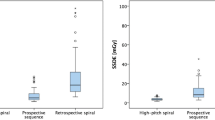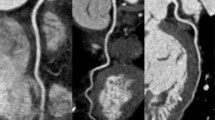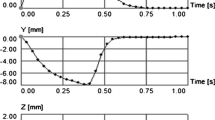Abstract
Objectives
To investigate the impact of an adaptive detector collimation on the dose parameters and accurateness of scan length adaption at prospectively ECG-triggered sequential cardiac CT with a wide-detector third-generation dual-source CT.
Methods
Ideal scan lengths for human hearts were retrospectively derived from 103 triple-rule-out examinations. These measures were entered into the new scanner operated in prospectively ECG-triggered sequential cardiac scan mode with three different detector settings: (1) adaptive collimation, (2) fixed 64 × 0.6-mm collimation, and (3) fixed 96 × 0.6-mm collimation. Differences in effective scan length and deviation from the ideal scan length and dose parameters (CTDIvol, DLP) were documented.
Results
The ideal cardiac scan length could be matched by the adaptive collimation in every case while the mean scanned length was longer by 15.4% with the 64 × 0.6 mm and by 27.2% with the fixed 96 × 0.6-mm collimation. While the DLP was almost identical between the adaptive and the 64 × 0.6-mm collimation (83 vs. 89 mGycm at 120 kV), it was 62.7% higher with the 96 × 0.6-mm collimation (135 mGycm), p < 0.001.
Conclusion
The adaptive detector collimation for prospectively ECG-triggered sequential acquisition allows for adjusting the scan length as accurate as this can only be achieved with a spiral acquisition. This technique allows keeping patient exposure low where patient dose would significantly increase with the traditional step-and-shoot mode.
Key points
• Adaptive detector collimation allows keeping patient exposure low in cardiac CT.
• With novel detectors the desired scan length can be accurately matched.
• Differences in detector settings may cause 62.7% of excessive dose.



Similar content being viewed by others
Abbreviations
- CT:
-
computed tomography
- CCTA:
-
coronary CT angiography
- CTDIvol:
-
computed tomography dose index volume
- DLP:
-
dose-length product
- ECG:
-
electrocardiogram
References
Taylor AJ, Cerqueira M, Hodgson JM et al (2010) ACCF/SCCT/ACR/AHA/ASE/ASNC/NASCI/SCAI/SCMR 2010 Appropriate use criteria for cardiac computed tomography. A report of the American College of Cardiology Foundation Appropriate Use Criteria Task Force, the Society of Cardiovascular Computed Tomography, the American College of Radiology, the American Heart Association, the American Society of Echocardiography, the American Society of Nuclear Cardiology, the North American Society for Cardiovascular Imaging, the Society for Cardiovascular Angiography and Interventions, and the Society for Cardiovascular Magnetic Resonance. Circulation 122:e525–e555
Sun Z, Ng KH (2012) Prospective versus retrospective ECG-gated multislice CT coronary angiography: a systematic review of radiation dose and diagnostic accuracy. Eur J Radiol 81:e94–100
Sabarudin A, Sun Z, Ng KH (2012) A systematic review of radiation dose associated with different generations of multidetector CT coronary angiography. J Med Imaging Radiat Oncol 56:5–17
Ghoshhajra BB, Engel LC, Major GP et al (2012) Evolution of coronary computed tomography radiation dose reduction at a tertiary referral center. Am J Med 125:764–772
Takx RA, Blomberg BA, El Aidi H et al (2015) Diagnostic accuracy of stress myocardial perfusion imaging compared to invasive coronary angiography with fractional flow reserve meta-analysis. Circ Cardiovasc Imaging 8
Bamberg F, Marcus RP, Becker A et al (2014) Dynamic myocardial CT perfusion imaging for evaluation of myocardial ischemia as determined by MR imaging. JACC Cardiovasc Imaging 7:267–277
Greif M, von Ziegler F, Bamberg F et al (2013) CT stress perfusion imaging for detection of haemodynamically relevant coronary stenosis as defined by FFR. Heart 99:1004–1011
Huber AM, Leber V, Gramer BM et al (2013) Myocardium: dynamic versus single-shot CT perfusion imaging. Radiology 269:378–386
Kurata A, Kawaguchi N, Kido T et al (2013) Qualitative and quantitative assessment of adenosine triphosphate stress whole-heart dynamic myocardial perfusion imaging using 256-slice computed tomography. PLoS One 8:e83950
Rochitte CE, George RT, Chen MY et al (2014) Computed tomography angiography and perfusion to assess coronary artery stenosis causing perfusion defects by single photon emission computed tomography: the CORE320 study. Eur Heart J 35:1120–1130
Sharma RK, Arbab-Zadeh A, Kishi S et al (2015) Incremental diagnostic accuracy of computed tomography myocardial perfusion imaging over coronary angiography stratified by pre-test probability of coronary artery disease and severity of coronary artery calcification: The CORE320 study. Int J Cardiol 201:570–577
Sun Z, Ng KH (2012) Diagnostic value of coronary CT angiography with prospective ECG-gating in the diagnosis of coronary artery disease: a systematic review and meta-analysis. Int J Cardiovasc Imaging 28:2109–2119
Menke J, Unterberg-Buchwald C, Staab W, Sohns JM, Seif Amir Hosseini A, Schwarz A (2013) Head-to-head comparison of prospectively triggered vs retrospectively gated coronary computed tomography angiography: Meta-analysis of diagnostic accuracy, image quality, and radiation dose. Am Heart J 165:154–163.e153
Qin J, Liu LY, Fang Y et al (2012) 320-detector CT coronary angiography with prospective and retrospective electrocardiogram gating in a single heartbeat: comparison of image quality and radiation dose. Br J Radiol 85:945–951
Liu B, To Thb TL, Hsieh J, Tank X (2012) Simulation and analysis of image quality impacts from single source, ultra-wide coverage CT scanner. J X-Ray Science Technol 20:395–404
Pack J (2013) Mitigation of cone-beam artifacts in short-scan CT imaging for large cone angle scans. 12th conference Fully 3D imaging proceedings
Schilham A, van der Molen AJ, Prokop M, de Jong HW (2010) Overranging at multisection CT: an underestimated source of excess radiation exposure. Radiographics 30:1057–1067
Tzedakis A, Damilakis J, Perisinakis K, Stratakis J, Gourtsoyiannis N (2005) The effect of z overscanning on patient effective dose from multidetector helical computed tomography examinations. Med Phys 32:1621–1629
Tzedakis A, Damilakis J, Perisinakis K, Karantanas A, Karabekios S, Gourtsoyiannis N (2007) Influence of z overscanning on normalized effective doses calculated for pediatric patients undergoing multidetector CT examinations. Med Phys 34:1163–1175
Deak PD, Langner O, Lell M, Kalender WA (2009) Effects of adaptive section collimation on patient radiation dose in multisection spiral CT. Radiology 252:140–147
Booij R, Dijkshoorn ML, van Straten M (2017) Efficacy of a dynamic collimator for overranging dose reduction in a second- and third-generation dual source CT scanner. Eur Radiol. https://doi.org/10.1007/s00330-017-4745-8
Trevisan D, Bonutti F, Ravanelli D, Valentini A (2014) Real time evaluation of overranging in helical computed tomography. Phys Med 30:968–972
Shirasaka T, Funama Y, Hayashi M et al (2012) Reduction of the unnecessary dose from the over-range area with a spiral dynamic z-collimator: comparison of beam pitch and detector coverage with 128-detector row CT. Radiol Phys Technol 5:53–58
User manual. GE Revolution CT
User manual. Toshiba Aquillion One
Kobayashi M, Koshida K, Suzuki S, Katada K (2011) Evaluation of geometric efficiency and radiation exposure in z-axis for volume scan. Radiat Prot Dosimetry 143:63–68
Johnston JH, Podberesky DJ, Yoshizumi TT et al (2013) Comparison of radiation dose estimates, image noise, and scan duration in pediatric body imaging for volumetric and helical modes on 320-detector CT and helical mode on 64-detector CT. Pediatr Radiol 43:1117–1127
Podberesky DJ, Angel E, Yoshizumi TT et al (2013) Comparison of radiation dose estimates and scan performance in pediatric high-resolution thoracic CT for volumetric 320-detector row, helical 64-detector row, and noncontiguous axial scan acquisitions. Acad Radiol 20:1152–1161
Podberesky DJ, Angel E, Yoshizumi TT et al (2012) Radiation dose estimation for prospective and retrospective ECG-gated cardiac CT angiography in infants and small children using a 320-MDCT volume scanner. AJR Am J Roentgenol 199:1129–1135
Kroft LJ, Roelofs JJ, Geleijns J (2010) Scan time and patient dose for thoracic imaging in neonates and small children using axial volumetric 320-detector row CT compared to helical 64-, 32-, and 16- detector row CT acquisitions. Pediatr Radiol 40:294–300
Perisinakis K, Papadakis AE, Damilakis J (2009) The effect of X-ray beam quality and geometry on radiation utilization efficiency in multidetector CT imaging. Med Phys 36:1258–1266
Funding
The authors state that this work has not received any funding.
Author information
Authors and Affiliations
Corresponding author
Ethics declarations
Guarantor
The scientific guarantor of this publication is Ralf W. Bauer.
Conflict of interest
The authors of this manuscript declare relationships with the following companies: Ralf W. Bauer is on the speakers’ bureau of Siemens Healthcare, Bayer Healthcare and GE Healthcare. The other authors state no conflicts of interest.
Statistics and biometry
No complex statistical methods were necessary for this paper.
Ethical approval
Institutional Review Board approval was not required because of phantom study.
Informed consent
Written informed consent was not required for this study because no patient data were handled for this manuscript.
Methodology
retrospective, experimental, performed at one institution.
Rights and permissions
About this article
Cite this article
Messerli, M., Dewes, P., Scholtz, JE. et al. Evaluation of an adaptive detector collimation for prospectively ECG-triggered coronary CT angiography with third-generation dual-source CT. Eur Radiol 28, 2143–2150 (2018). https://doi.org/10.1007/s00330-017-5177-1
Received:
Revised:
Accepted:
Published:
Issue Date:
DOI: https://doi.org/10.1007/s00330-017-5177-1




